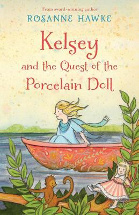Kelsey and the Quest of the Porcelain Doll by Rosanne Hawke

University of Queensland Press, 2014. ISBN: 9780702253317.
Highly recommended for ages 7+. Kelsey is made to travel to Pakistan
with her aid worker parents after a flood. She is resentful and
wishes she could have remained at home with Nanna Rose, able to
celebrate her ninth birthday at her friend Chantelle's pool.
Instead, she finds herself in unfamiliar surroundings with people
she doesn't know and with whom she certainly doesn't want to spend
time! Gradually she is encouraged to make friends with a girl of her
own age and visit her home. As often as she can, Kelsey skypes Nanna
Rose who obliges by telling her stories about a porcelain doll and
its adventures. Over time, Kelsey learns to appreciate her new
friend Shakila and her family and their way of life and enjoys her
visits to the local school. When an accident occurs, Kelsey is able
to show her true nature. Will everything turn out for the best or
not and will Amy Jo, the porcelain doll, ever find her 'happy ever
after'?
Having begun its life as a story told by the author to her daughter
while they were living in Pakistan, the story highlights Hawke's
affinity with both the people and place of her tale. With each
chapter's focus alternating between the story of Kelsey and her
experiences and the tale of Amy Jo, the porcelain doll, this story
is accessible to younger readers but would also make a great read
aloud. The print is double spaced, there are illustrations directly
related to each chapter on its first page and blank pages between
each chapter, hence, the text is probably only around one hundred
pages in length. This all serves to make Kelsey a title which would
be perfect to use with a class. One could focus on children from
other countries, differences between families, natural disasters,
aid work and practical responses students could make in the way of
support. As stated on the blurb on the back cover, it is a
'captivating story of adversity, adventure and love.' Each of these
aspects is dealt with and could be teased out, even with young
children. I can imagine this book being paired with any of the
Sarindi titles to compare and contrast the information found in
each.
Jo Schenkel